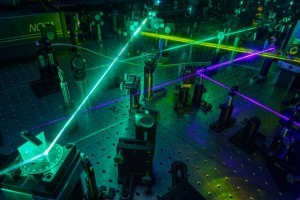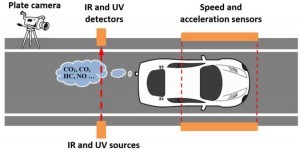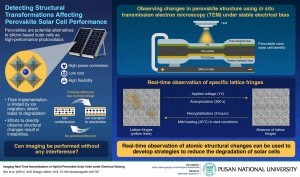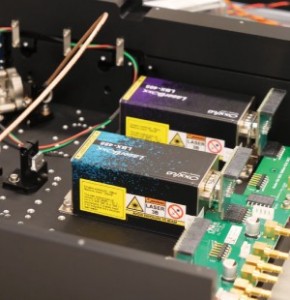
In Hong Kong, a remote sensing system with a camera and light beam detect high-polluting cars and summon the driver to an emissions test. At the University of Potsdam, a study shows how terahertz and microwave spectroscopy are used on semiconducting materials and may help predict efficiency and losses in solar cells. And researchers in Korea and the US have used in-situ transmission electron microscopy imaging to observe changes in the structure of a perovskite solar cell.
Seeing polluters
Hong Kong is notorious for poor air quality, but an enforcement program could help identify one pollution source—automobiles—and bring them in for emissions testing. Hong Kong launched an on-road remote sensing program to check vehicle emissions as the cars drive by. A dual method was used, whereby emissions were checked i.e., CO2, CO, HC, and NO), driving conditions (i.e., speed and acceleration), and license plate number (for obtaining vehicle registration information) are measured twice when a vehicle passes by an RS site.

"Remote sensing equipment uses a sensor and light beam to measure chemical concentrations in the exhaust as a vehicle drives past. A camera records the licence plate, so vehicles can be identified for inspection and repair," says research co-author, Professor John Zhou from the University of Technology Sydney (UTS).
Researchers from UTS partnered with the Hong Kong Environmental Protection Department (HKEPD) and the Hong Kong Vocational Training Council to evaluate the accuracy and effectiveness of Hong Kong's remote sensing enforcement program. They examined data that included around 2.9 million vehicle counts from over 150 monitoring sites. They also looked at air quality monitoring and chassis dynamometer testing data. In total, 16,365 high-emitting LPG and petrol vehicles were identified by remote sensing and issued with emission test notices. Among them, 96.3% of the high emitters were successfully repaired and subsequently passed the Hong Kong Transient Emission Test (HKTET). Only 1.4% of vehicles failed the HKTET, and 2.3% of vehicles did not take the test, but they were taken off the road because the driver lost their license.
Some of the challenges in the testing including conservative setting of emission cut points, the need for single-lane measurement sites, and the lack of application in diesel vehicles, but the researchers believe that with more sensitive remote sensing systems and vertical systems, these issues will be alleviated.
Read “Remote Sensor with Light and Camera Detect Source of Urban Pollution”
Using spectroscopy to predict solar cell performance
Perovskite semiconductors are the focus of much research these days, as They are inexpensive and easy to process and enable high efficiencies. A recent study used conducted by 15 participating research institutions shows how terahertz (TRTS) and microwave spectroscopy (TRMC) can be used to reliably determine the mobility and lifetime of the charge carriers in new semiconducting materials.
The researchers looked at the mobility and lifetime of electrons and "holes”—measured without contacts with spectroscopic methods using terahertz or microwave radiation. However, measurement data found in literature often differ by orders of magnitude.

One result of the joint work is the significantly more precise determination of the transport properties with terahertz or microwave spectroscopy. "We could identify some neuralgic points that have to be considered before the actual measurements takes place, which allows us to arrive at significantly better agreement of the results," says Dr. Hannes Hempel from the HZB team led by Dr. Thomas Unold.
Another result of the study: With reliable measurement data and a more advanced analysis, the characteristics of the solar cell can also be calculated more precisely. "We believe that this analysis is of great interest for photovoltaic research, because it predicts the maximum possible efficiency of the material in a solar cell and reveals the influence of various loss mechanisms, such as transport barriers," said Unold. This applies not only to the material class of perovskite semiconductors, but also to other new semiconducting materials, which can thus be tested more quickly for their potential suitability.
Read “Predicting Solar Cell Performance from Terahertz and Microwave Spectroscopy”.
Microscopy technique sheds light on degradation in perovskite solar
While perovskites are considered potential alternatives to conventional silicon-based solar cells, instabilities due to ion migration limit their commercial viability. Previous research determined that when the perovskite cells are exposed to sunlight, freely moving ion vacancies form in the structure and migrate towards the electrodes. In dark conditions, the effect is reversed, and the ions are once again redistributed in the perovskite structure. Repeated cycles of this ion transport during the operation of the solar cell permanently degrade the cell and result in short lifetimes. However, degradation at the atomic level due to ion migration has not been directly observed. Researchers from Korea and the US used microscopy-based imaging technique to observe structural changes at the atomic level suggesting strategies to reduce the degradation.
The researchers used an in-situ transmission electron microscopy (TEM) imaging technique. “This work offers vital insights on understanding ion migration and addressing instability challenges of perovskite optoelectronics”, explains Assistant Professor Min-cheol Kim of the Department of Mechanical Engineering, Pusan University, who led the study.
While electron microscopy has the scope to image structures at the atomic scale, the instability of the perovskite structure towards an external electrical bias (voltage) makes it challenging to monitor it for structural changes. The trick was to image the perovskites under a stable voltage. They observed a gradual disappearance of the lattice fringes of perovskite crystals, which indicated the “amorphization” of the structure. As is the case with perovskite crystals, amorphization was observed to be reversible under dark conditions. However, using TEM, the researchers noticed that recrystallization was faster when the sample was subjected to mild heating at 50°C.
“This work not only demonstrates the ability to achieve real-time imaging of perovskite amorphization but also provides an effective method to recover the degraded performance of PSCs related to ion instability,” Said Prof. Kim
Read “Microscopy Helps to Image Real-Time Structural Changes in Perovskite Cells”.
Implementation of state-of-the-art research techniques such as these are paving the way for improvements in materials and methods, which will one day help to further reduce carbon in the atmosphere—thus making the world a greener place.
Written by Anne Fischer, Editorial Director of Novus Light Technologies Today
































 Back to Features
Back to Features



























